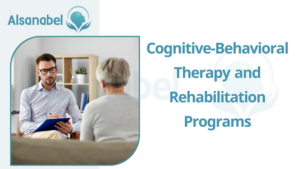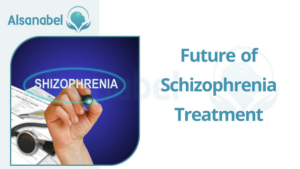The Evolution of Schizophrenia Treatment 2023
- Category ADHD
Schizophrenia is a chronic mental disorder that affects how a person thinks, feels, and behaves. It is marked by symptoms such as delusions, hallucinations, disorganized thinking, and a lack of motivation. While there is no cure for it, there are various schizophrenia treatment options available that can help manage the symptoms and improve the quality of life for individuals living with the condition.
Overview of schizophrenia and its treatment options
Schizophrenia is typically treated using a combination of medication, therapy, and support from healthcare professionals. Medications such as antipsychotics are commonly prescribed to help control the symptoms of schizophrenia. These medications work by altering the balance of chemicals in the brain to reduce hallucinations, delusions, and other symptoms.
Psychosocial interventions, such as cognitive-behavioral therapy (CBT), family therapy, and social skills training, are also used to help individuals with it manage their symptoms and improve their functioning. These therapies can help individuals learn coping strategies, improve communication and problem-solving skills, and enhance social interactions.
In recent years, there has been growing interest in alternative and complementary treatments for it, such as exercise, nutritional supplements, and mindfulness-based interventions. While more research is needed to fully understand the effectiveness of these treatments, they show promise in improving symptoms and overall well-being.
Early Treatments for Schizophrenia

Emergence of moral therapy and humane approaches
In the past, the treatment of schizophrenia was largely centered around moral therapy and humane approaches. During the late 18th and early 19th centuries, mental asylums provided a refuge for individuals with mental illnesses, including this disorder. The focus was on creating a supportive and caring environment, where patients were treated with kindness and respect.
Moral therapy, developed by Philippe Pinel and William Tuke, emphasized the importance of treating individuals with mental disorders as human beings deserving of compassion and understanding. Patients were offered a structured daily routine, engaging in activities such as gardening, arts and crafts, and physical exercise. The aim was to promote mental and emotional well-being through a positive and therapeutic environment.
Evolution of hydrotherapy and insulin coma therapy
In the early 20th century, new treatment approaches emerged, including hydrotherapy and insulin coma therapy.
- Hydrotherapy involved the use of water to soothe and calm individuals with this disorder. Patients would spend time in specialized baths, receiving massages and other water-based treatments. It was believed that this therapy could help alleviate symptoms by promoting relaxation and reducing agitation.
- Insulin coma therapy, on the other hand, involved inducing a controlled coma by injecting insulin. This approach, developed in the 1930s, aimed to shock the system and “reset” the brain. While the exact mechanism of action was not fully understood at the time, some patients did experience a temporary reduction in symptoms following the treatment.
It is important to note that these early treatments for this disorder, including moral therapy, hydrotherapy, and insulin coma therapy, were experimental and varied in their effectiveness. Over time, advancements in medical understanding and evidence-based research led to the development of more targeted and effective treatments for managing schizophrenia.
Today Treatment Options
Today, treatment options for schizophrenia include a combination of medications, therapy, and psychosocial interventions. These treatments have evolved based on a better understanding of the neurobiology of the disorder and the specific needs of individuals living with it.
- Medications such as antipsychotics are commonly prescribed to manage symptoms and improve overall functioning.
- Psychosocial interventions, including cognitive-behavioral therapy and family therapy, help individuals develop coping strategies and enhance their social interactions.
- Emerging approaches, such as exercise, nutritional supplements, and mindfulness-based interventions, show promise in complementing traditional treatments.
By studying the evolution of treatment options for schizophrenia, researchers and healthcare professionals can continue to improve the care provided to individuals living with this complex mental disorder. With ongoing advancements in technology and scientific research, the hope is that more targeted and personalized treatment approaches will be developed, further enhancing the quality of life for those with schizophrenia.
Psychopharmacological Revolution
In the mid-1950s, a significant breakthrough occurred in the treatment of schizophrenia with the introduction of chlorpromazine. This antipsychotic medication revolutionized the approach to managing symptoms and improving the overall functioning of individuals with schizophrenia.
The use of chlorpromazine brought about substantial changes in the lives of people living with schizophrenia. Prior to its introduction, individuals with schizophrenia often experienced severe and debilitating symptoms that hindered their ability to function in society. The use of chlorpromazine not only reduced hallucinations, delusions, and disorganized thinking but also helped individuals regain some level of control over their emotions and behaviors.
This medication played a vital role in deinstitutionalizing mental health care, as it made it possible for individuals with schizophrenia to be treated in community-based settings rather than long-term institutionalized care. It allowed for a shift towards a more integrated approach of care, where individuals with schizophrenia could receive treatment while still being a part of society.
Exploration of other antipsychotic medications
Following the introduction of chlorpromazine, scientists and researchers continued to explore and develop other antipsychotic medications to provide alternative treatment options for individuals with schizophrenia. These medications aimed to improve the management of symptoms, reduce side effects, and enhance overall treatment outcomes.
Some of the notable antipsychotic medications that followed chlorpromazine include:
- Haloperidol (Haldol): This medication, introduced in the 1960s, is a high-potency antipsychotic that can effectively reduce psychotic symptoms. It became widely used due to its effectiveness and lower sedative properties compared to earlier antipsychotics.
- Clozapine (Clozaril): Developed in the 1970s, clozapine marked a significant advancement in schizophrenia treatment. It demonstrated superior efficacy in treating refractory schizophrenia, meaning it was effective for individuals who did not respond well to other antipsychotics. However, it also carries the risk of serious side effects, including agranulocytosis, a decrease in white blood cells.
- Second-generation (atypical) antipsychotics: Introduced in the 1990s, these antipsychotics, such as risperidone, olanzapine, and quetiapine, aimed to provide improved symptom control and reduce side effects compared to earlier medications. They work by targeting both dopamine and serotonin receptors in the brain.
These advancements in pharmacological treatments have significantly improved the prognosis for individuals with schizophrenia. While medication management remains a crucial component of treatment, it is often combined with psychosocial interventions, therapy, and support services to provide comprehensive care and maximize the individual’s quality of life.
Deinstitutionalization and Community Mental Health
Shift towards community-based care and the closure of psychiatric hospitals
In the mid-20th century, the introduction of effective antipsychotic medications, such as chlorpromazine, led to a significant shift in the treatment of schizophrenia. This shift was accompanied by the deinstitutionalization movement, which aimed to provide care for individuals with mental illnesses in community-based settings rather than long-term institutionalized care.
As antipsychotic medications became more accessible and effective, the need for extensive hospitalization decreased. Psychiatric hospitals, which were once the primary locations for treating individuals with schizophrenia, began to close their doors. Instead, a more integrated approach to care was adopted, allowing individuals to receive treatment while still being a part of society.
This shift towards community-based care brought about several benefits. It enabled individuals with schizophrenia to live more independent lives, supported by outpatient services, community mental health centers, and housing programs. Furthermore, it encouraged the involvement of family and friends in the care and support of individuals, promoting a sense of belonging and reducing the social stigma associated with mental illness.
Impact on schizophrenia treatment and patient outcomes
The introduction of community-based care had a significant impact on schizophrenia treatment and patient outcomes. It allowed for a holistic approach to treatment, combining medication management with psychosocial interventions, therapy, and support services.
The focus on community-based care emphasized the importance of early intervention and continued treatment adherence. With regular access to outpatient services and support, individuals with schizophrenia were able to receive ongoing monitoring, medication adjustments, and therapy sessions. This comprehensive approach improved symptom control, reduced relapse rates, and enhanced overall patient well-being.
Additionally, community mental health services provided a range of support programs tailored to the specific needs of individuals with schizophrenia. These programs included vocational rehabilitation, housing assistance, social skills training, and peer support groups. Such resources aimed to improve quality of life, enhance functional abilities, and promote a sense of inclusion in society.
Although deinstitutionalization and community mental health brought about positive changes, they also presented challenges. The closure of psychiatric hospitals sometimes resulted in a lack of adequate community resources, leading to gaps in care. Additionally, the burden of care shifted to families and communities, who may not always have the necessary support or resources to provide comprehensive care.
Cognitive-Behavioral Therapy and Rehabilitation Programs

Introduction of CBT for schizophrenia management
Cognitive-Behavioral Therapy (CBT) has emerged as a valuable treatment approach for individuals with schizophrenia. This therapy focuses on addressing the distorted thoughts and beliefs that contribute to psychotic symptoms, as well as developing coping strategies to manage them. By targeting both the cognitive and behavioral aspects of the illness, CBT helps individuals gain better control over their symptoms and improve their overall functioning. Studies have shown that CBT can significantly reduce positive symptoms such as hallucinations and delusions, as well as improve negative symptoms and overall quality of life for individuals with schizophrenia.
Innovative rehabilitation programs to improve functioning and quality of life
In addition to CBT, rehabilitation programs have been developed to help individuals with schizophrenia improve their functioning and enhance their quality of life. These programs aim to address the various areas of impairment that can result from the illness, such as social and occupational difficulties. They provide a structured and supportive environment where individuals can learn and practice essential skills for daily living, interpersonal relationships, and employment.
Rehabilitation programs often include vocational training, social skills development, and support in finding and maintaining employment opportunities. These interventions have shown promising results in helping individuals with schizophrenia reintegrate into society, achieve independence, and experience a higher level of well-being.
Advancements in Brain Stimulation Techniques
Transcranial Magnetic Stimulation
Transcranial Magnetic Stimulation (TMS) has emerged as a significant advancement in the treatment of schizophrenia. This non-invasive technique involves applying magnetic fields to specific regions of the brain to stimulate or inhibit neural activity.
TMS has shown promise in reducing positive symptoms such as hallucinations and improving cognitive functioning in individuals with schizophrenia. It offers a safe and well-tolerated alternative to traditional pharmacological interventions, with minimal side effects. TMS can be used as an add-on therapy to medication or as a stand-alone treatment option. However, further research is needed to fully understand its long-term effectiveness and optimize treatment protocols.
Deep Brain Stimulation
Deep Brain Stimulation (DBS) is a surgical procedure in which electrodes are implanted into specific brain regions to deliver electrical impulses. Initially developed for neurological conditions such as Parkinson’s disease, DBS has shown promise as a treatment option for individuals with treatment-resistant schizophrenia.
The electrical stimulation targets specific brain circuits involved in the pathophysiology of schizophrenia, potentially reducing symptoms and improving overall functioning. Although DBS is still considered an experimental treatment for schizophrenia, early studies have reported encouraging results. However, the procedure carries potential risks and considerations, and more extensive research and clinical trials are needed to establish its safety and long-term effectiveness.
Integrated and Personalized Approaches
Incorporation of psychosocial interventions alongside medication
In addition to pharmacological interventions, incorporating psychosocial interventions into the treatment of schizophrenia has shown promising results. Therapy modalities such as Cognitive Behavioral Therapy (CBT) and Social Skills Training (SST) can help individuals with schizophrenia manage symptoms, improve coping skills, and enhance overall functioning.
These interventions focus on addressing specific challenges such as delusions, social withdrawal, and difficulties in communication. By combining medication with psychosocial interventions, individuals with schizophrenia can benefit from a comprehensive treatment approach that targets both the biological and psychosocial aspects of the condition.
Benefits of individualized treatment plans
Each person with schizophrenia has unique needs and experiences, which is why the development of personalized treatment plans is crucial. By tailoring interventions and medications to the individual, better outcomes can be achieved. Personalized treatment plans take into account factors such as symptom severity, response to different medications, and individual preferences. They may also incorporate the individual’s social supports, living situation, and goals for treatment. By creating an individualized approach, healthcare providers can better address the multifaceted nature of schizophrenia and target interventions that are most effective for each person.
Future of Schizophrenia Treatment

Emerging research and potential breakthroughs
Researchers and scientists are constantly exploring new avenues for the treatment of schizophrenia, with the aim of improving outcomes and enhancing the quality of life for individuals living with this condition. Emerging research has provided insights into potential breakthroughs that may revolutionize schizophrenia treatment.
One area of interest is the development of novel medications that target specific neurotransmitter systems in the brain. These medications aim to modulate the abnormal brain chemistry associated with schizophrenia and may offer improved symptom management with fewer side effects. Additionally, researchers are investigating the potential of innovative therapies, such as virtual reality-based interventions, to enhance cognitive functioning and social skills in individuals with schizophrenia.
Targeted therapies and genetic interventions
Advancements in technology and our understanding of genetics have opened up new possibilities for targeted therapies and genetic interventions in schizophrenia treatment. By identifying specific genetic markers associated with the condition, researchers hope to develop tailored treatment approaches that address the underlying biological factors contributing to schizophrenia.
Genetic interventions may involve gene editing techniques or the use of gene therapies to correct or modulate the expression of certain genes implicated in schizophrenia. These approaches hold great promise in terms of personalized medicine and providing more effective and precise treatments for individuals with schizophrenia.
In addition, advancements in neuroimaging techniques allow for a better understanding of the structural and functional changes in the brain that occur in schizophrenia. This knowledge has the potential to inform the development of targeted interventions aimed at restoring brain connectivity and function.
The future of schizophrenia treatment holds exciting possibilities, with ongoing research and technological advancements paving the way for more effective, personalized, and holistic approaches. By continuing to explore innovative treatment modalities and gaining a deeper understanding of the underlying causes of schizophrenia, healthcare providers can offer individuals with this condition a brighter and more hopeful future.
Importance of continual research and advancements
It is crucial to continue investing in research and advancements in schizophrenia treatment. By exploring innovative treatment modalities and gaining a deeper understanding of the underlying causes of the condition, healthcare providers can offer individuals with schizophrenia a brighter and more hopeful future. Ongoing research will help identify new breakthroughs and refine existing treatments to enhance outcomes and quality of life for patients.
Future research should focus on further unraveling the complex genetic and neurobiological mechanisms underlying schizophrenia. This knowledge can inform the development of more targeted interventions aimed at restoring brain connectivity and function. Furthermore, continued research into the effectiveness of psychosocial interventions, such as therapy and support programs, can contribute to holistic treatment approaches that address the unique needs of individuals with schizophrenia.
In conclusion, the future of schizophrenia treatment holds exciting possibilities. With advancements in medication, therapies, genetic interventions, and our understanding of the condition, there is potential for more precise, personalized, and effective treatment options. By ongoing research and continual advancements, healthcare providers can strive to improve the lives of individuals with schizophrenia and offer them better outcomes and a higher quality of life.









